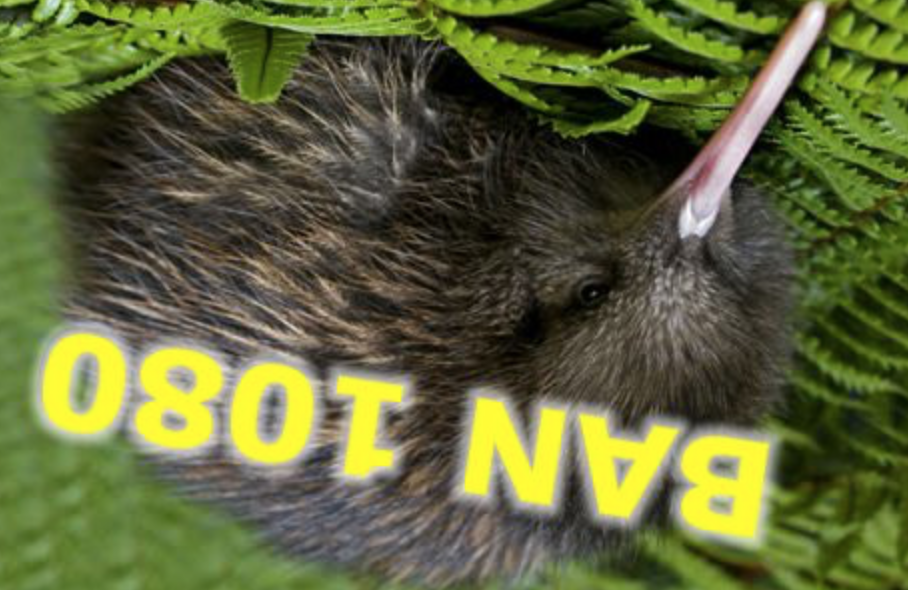
DOC and agencies stand up for 1080 to protect New Zealand’s forests and wildlife
The Department of Conservation (DOC) is fully committed to the use of 1080 to protect our forests and native wildlife in the face of the current campaign of misinformation and is joined by other agencies in standing up for the use of this pesticide.
New Zealand’s native wildlife is in crisis. The flocks of native birds that used to fill our forests have been killed and replaced by vast populations of rats, possums, stoats and other introduced predators. This is not the future most New Zealanders want.
DOC, OSPRI (TBfree NZ), Federated Farmers, Forest & Bird and WWF-NZ all agree that 1080 is an effective, safe and valuable tool in the fight to protect New Zealand’s forests and native birds, bats, insects and lizards.
The agencies above, along with community groups and volunteers, invest huge amounts of time and effort to protect out native taonga from predation. There are multiple tools and technologies used to control predators of which 1080 is one. 1080 is a highly effective toxin and a necessary tool to help protect our native species.
We use a range of methods including the latest self-setting traps and there is significant research being undertaken into pest control technologies. However, Forest and Bird volunteer trappers agree they could never cover the vast and inaccessible areas that aerial 1080 operations can. Biodegradable aerial 1080 is the most effective tool we have for suppressing rats, possums and stoats in one operation over large, difficult to access wilderness areas—where most of our native wildlife lives.
These organisations use or advocate for 1080 because it is backed by years of rigorous testing, review and research by scientists from Landcare Research, Universities, the Environmental Protection Authority (EPA), Ministry of Health and the independent Parliamentary Commissioner for the Environment.
In 2011, the former Parliamentary Commissioner for the Environment, Dr Jan Wright wrote a comprehensive report on 1080 and the current Parliamentary Commissioner, Dr Simon Upton, stands by Dr Wright’s analysis and recommendations.
The results are clear that where 1080 is used, our birds and native wildlife start to flourish.
We understand that some New Zealanders have genuine concerns and fears about 1080 in relation to the environment, water, animal welfare and wild food sources. We urge them to seek out www.1080thefacts.co.nz that addresses these issues.
New Zealanders have a choice: use 1080 to protect our native species over large-scale wilderness areas or end up with collapsing and denuded forests and our native species restricted to pest-free islands and fenced sanctuaries.
https://www.doc.govt.nz/standupfor1080
Lou Sanson
Director-General, Department of Conservation
Chris Allen
Board Member, Federated Farmers
Barry Harris,
Chair, OSPRI
Kevin Hague
Chief Executive, Royal Forest and Bird Protection Society
Livia Esterhazy
Chief Executive, WWF-NZ






This means war.
Can you ask any of those signatories at what point was it approved to deliberately kill native birds in the last few weeks by the hundreds to play God and create their own eco system in a bottle at a point in history chosen by them?
If you don’t know what I am referring to search for Rakitu Island. Contact DOC directly on Great Barrier Island, as anything I reference will be dismissed as conspiracy theory. Before you do present them with these questions.
1) Is (was) there a population of native threatened weka numbering between 250 and 500 resident on Rakitu Island, a couple of kilometres east of Great Barrier Island?
2) is it true that DOC removed between 60 and 70 of them from this sub tropical island and removed them to Mt Bruce, a bitterly cold part of the lower north island, in the middle of winter?
3) What do they expect the survival rate for these birds will be, from the impact of capture, caging, transporting and putting into a completely different environment than the one they came from?
Now the big question.
4) Is it true, that even knowing that there were over 200 and up to 450 native flightless birds on the island DOC still went ahead and dropped tonnes of brodifacoum all over the island, ostensibly to kill rats, but knowing that the weka are likely to succumb to the poison also? Not only from directly ingesting, but also from the fact they predate on rats and will eat the carcasses of the dead ones poisoned by brodifacoum?
5) Is it also true that according to a report commissioned by DOC by the Northern Seabird Trust, there are at least 25 other species of native bird on the island, including the very rare pateke, kereru, morepork, hawk, waxeye, tui, fantails and many others?
6) At what point did it change from “we’re trying to save everything but occasionally you get collateral damage and accidental bykill” (sounding like the Saudi military there)…………to “bugger it, we want a seabird sanctuary but those pesky weka are a pain in the arse as they will eat the seabird eggs and small chick so we have to get rid of them so lets poison the bloody lot while we take a few off to pretend we are trying to save them…….”
Get back to me when you’ve spoke to DOC about it. Then make sure you let our media know, because so far they have been totally complicit in shutting this down. I have no idea why.
This country is being turned into a toxic wasteland from aerial poison drops to polluted waterways from intensive farming while all the good bits and clean water are being sold off to foreign interest. And it is happening under political parties of all hues. WTF happened to NZ?
Hardly what you would call compassionate conservation, but just the ‘Imperial’ attitude with an over regard for the imposition of technical solutions that got us into the problems with the environment in the first place-Graham
“but just the ‘Imperial’ attitude with an over regard for the imposition of technical solutions that got us into the problems with the environment in the first place-“
What do you suggest in lieu of a “technical” solution? wishful thinking? transcendental meditation? Asking the pests nicely to leave?
Really, what do you suggest? What has a realistic chance of controlling the pests or and hasn’t been considered or tried already?
No, it’s employing an evidence based solution to an urgent problem that exists right now. The mixed origins of this problem have little bearing on possible solutions.
Did you not read Shane Hyde’s comments on Christine’s blog below?
Or the enthusiastic queries about how to get similar efforts off the ground? The plan is there and the enthusiasm to participate. It doesn’t even seem that it would necessarily cost more though I expect it would. And extra money spent on paying participants would immediately circulate through the community. The issue is a philosophical one , not a practical one. Better to support a helicopter contractor than 20 beneficiaries.
D J S
Eh? It would be a little strange if a project manager of pest irradiation says one day, “I know, let’s support beneficiaries.” It’s not really salt and pepper.
The DOC propaganda campaign here doesn’t seem to be making much headway does it!
D J S
Much of the so called testing and trialling of 1080 is reductionist.
1080 does not degrade to vinegar and salt.
1080 degrades to highly toxic and dangerous by products that flush into ground water, our streams and rivers and get swept out to sea.
NZ Forest Service, a fore runner of DOC had a stoat breeding program and released them to control rabbits. Short sighted reductionist thinking should not be defended. It is dangerous.
http://1080science.co.nz/1080-chemistry/
By no means a complete analysis as one doesn’t exist. But warnings should not be over ridden.
1080 is a cost saving PR measure not an effective control of pests.
Many countries and states have banned 1080 and that is not just because they have native land animals.
Comments are closed.